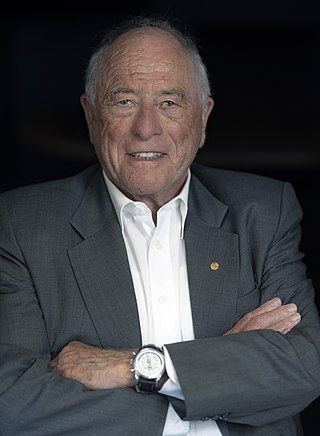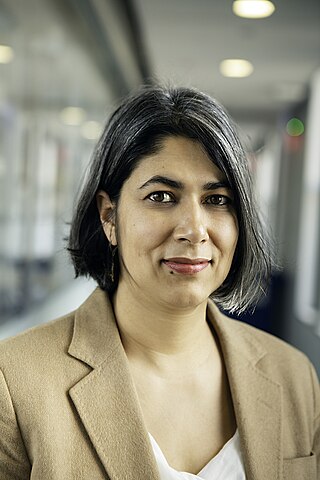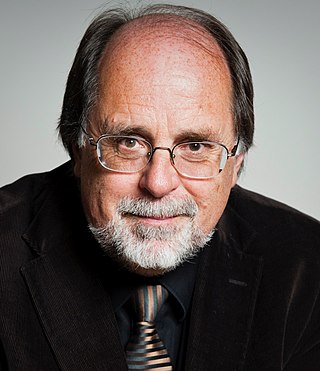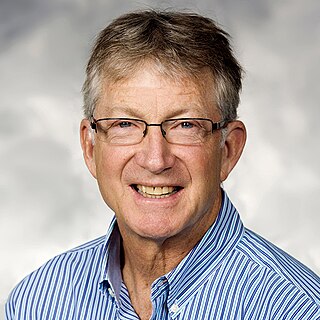Related Research Articles

Kurt Wüthrich is a Swiss chemist/biophysicist and Nobel Chemistry laureate, known for developing nuclear magnetic resonance (NMR) methods for studying biological macromolecules.

The Consortium for Functional Glycomics (CFG) is a large research initiative funded in 2001 by a glue grant from the National Institute of General Medical Sciences (NIGMS) to “define paradigms by which protein-carbohydrate interactions mediate cell communication”. To achieve this goal, the CFG studies the functions of:

Scripps Research, previously known as The Scripps Research Institute (TSRI), is a nonprofit American medical research facility that focuses on research and education in the biomedical sciences. Headquartered in San Diego, California, the institute has over 170 laboratories employing 2,100 scientists, technicians, graduate students, and administrative and other staff.
Raymond Allen Dwek CBE FRS FRSC is a scientist at the University of Oxford and co-founder of the biotechnology company Oxford GlycoSciences Ltd.

Kendall Newcomb Houk is a Distinguished Research Professor in Organic Chemistry at the University of California, Los Angeles. His research group studies organic, organometallic, and biological reactions using the tools of computational chemistry. This work involves quantum mechanical calculations, often with density functional theory, and molecular dynamics, either quantum dynamics for small systems or force fields such as AMBER, for solution and protein simulations.

Carolyn Ruth Bertozzi is an American chemist and Nobel laureate, known for her wide-ranging work spanning both chemistry and biology. She coined the term "bioorthogonal chemistry" for chemical reactions compatible with living systems. Her recent efforts include synthesis of chemical tools to study cell surface sugars called glycans and how they affect diseases such as cancer, inflammation, and viral infections like COVID-19. At Stanford University, she holds the Anne T. and Robert M. Bass Professorship in the School of Humanities and Sciences. Bertozzi is also an Investigator at the Howard Hughes Medical Institute (HHMI) and is the former director of the Molecular Foundry, a nanoscience research center at Lawrence Berkeley National Laboratory.
Dale Lester Boger is an American medicinal and organic chemist and former chair of the Department of Chemistry at The Scripps Research Institute in La Jolla, CA.
Richard D. Cummings is an American biochemist who is the S. Daniel Abraham Professor of Surgery at Beth Israel Deaconess Medical Center and Harvard Medical School in Boston, Massachusetts. He also the chief of the division of surgical sciences within the department of surgery. He is the director of the Harvard Medical School Center for Glycoscience, director of the National Center for Functional Glycomics, and also founder of the Glycomics Core at BIDMC. As of 2018 Cummings is also the scientific director of the Feihi Nutrition Laboratory at BIDMC. Before moving to BIDMC/HMS, Cummings was the William Patterson Timmie Professor and chair of the department of biochemistry at Emory University School of Medicine in Atlanta, Georgia from 2006 to 2015. At Emory, Cummings was a founder in 2007 of the Emory Glycomics Center.

Lara K. Mahal is an American chemist who is the Canada Excellence Research Chair in Glycomics at the University of Alberta in Edmonton, Alberta, Canada. She is also a Professor of Chemistry at the University of Alberta. She is notable both for her pioneering work establishing lectin microarrays as a new technology for glycomics, her work on miRNA regulation of glycosylation and her graduate work with Carolyn R. Bertozzi on unnatural carbohydrate incorporation. Work in her laboratory focuses on understanding the role of carbohydrates in human health using systems- and chemical biology-based approaches
Christopher T. Walsh was a Hamilton Kuhn professor of biological chemistry and pharmacology at Harvard Medical School. His research focused on enzymes and enzyme inhibition, and most recently focused on the problem of antibiotic resistance. He was elected to the National Academy of Sciences in 1989.
Laura Lee Kiessling is an American chemist and the Novartis Professor of Chemistry at the Massachusetts Institute of Technology. Kiessling's research focuses on elucidating and exploiting interactions on the cell surface, especially those mediated by proteins binding to carbohydrates. Multivalent protein-carbohydrate interactions play roles in cell-cell recognition and signal transduction. Understanding and manipulating these interactions provides tools to study biological processes and design therapeutic treatments. Kiessling's interdisciplinary research combines organic synthesis, polymer chemistry, structural biology, and molecular and cell biology.

Michael A. Marletta is an American biochemist. He was born in Rochester, New York, the son of Italian immigrants. He graduated from the State University of New York at Fredonia in 1973 with an A.B. degree in biology and chemistry, and from the University of California, San Francisco in 1978 with a Ph.D. degree in pharmaceutical chemistry, where he studied with George Kenyon. He was a postdoctoral fellow with Christopher T. Walsh at MIT from 1978-1980 and continued as a faculty member at MIT from 1980-1987 whereupon he joined the faculty of the University of Michigan, Ann Arbor. He was John G. Searle Professor of Medicinal Chemistry in the college of pharmacy and professor of biological chemistry at the University of Michigan. In 2001, he moved to the University of California, Berkeley to assume roles as Aldo DeBenedictis Distinguished Professor of Chemistry and professor of biochemistry and molecular biology, and served as the chair of the department of chemistry from 2005 until 2010. He was a Howard Hughes Medical Institute Investigator. From January 2012 to August 2014, Marletta was president and CEO of The Scripps Research Institute in La Jolla, California, succeeding Richard Lerner.
Alanna Schepartz is an American professor and scientist. She is currently the T.Z. and Irmgard Chu Distinguished Chair in Chemistry at University of California, Berkeley. She was formerly the Sterling Professor of Chemistry at Yale University.

Judith P. Klinman is an American chemist, biochemist, and molecular biologist known for her work on enzyme catalysis. She became the first female professor in the physical sciences at the University of California, Berkeley in 1978, where she is now Professor of the Graduate School and Chancellor's Professor. In 2012, she was awarded the National Medal of Science by President Barack Obama. She is a member of the National Academy of Sciences, American Academy of Arts and Sciences, American Association for the Advancement of Science, and the American Philosophical Society.

Milos Vratislav Novotny is an American chemist, currently the Distinguished Professor Emeritus and Director of the Novotny Glycoscience Laboratory and the Institute for Pheromone Research at Indiana University, and also a published author. Milos Novotny received his Bachelor of Science from the University of Brno, Czechoslovakia in 1962. In 1965, Novotny received his Ph.D. at the University of Brno. Novotny also holds honorary doctorates from Uppsala University, Masaryk University and Charles University, and he has been a major figure in analytical separation methods. Novotny was recognized for the development of PAGE Polyacrylamide Gel-filled Capillaries for Capillary Electrophoresis in 1993. In his years of work dedicated to analytical chemistry he has earned a reputation for being especially innovative in the field and has contributed a great deal to several analytical separation methods. Most notably, Milos has worked a great deal with microcolumn separation techniques of liquid chromatography, supercritical fluid chromatography, and capillary electrophoresis. Additionally, he is highly acclaimed for his research in proteomics and glycoanalysis and for identifying the first mammalian pheromones.
Robert L. Hill (1928-2012) was a biochemist who spent most of his career on the faculty at Duke University School of Medicine, from which he retired as the James B. Duke Professor Emeritus. Hill's research focused on the chemistry of enzymes, with particular specialization in glycosyltransferases and glycobiology.

Ari Helenius is a Finnish emeritus professor of biochemistry who is known for his research in virology.

James L. Skinner is an American theoretical chemist. He is the Joseph O. and Elizabeth S. Hirschfelder Professor Emeritus at the University Wisconsin-Madison. He is also a member of the Scientific Advisory Board of the Welch Foundation. Most recently, Skinner was the Crown Family Professor of Molecular Engineering, professor of chemistry, director of the Water Research Initiative and deputy dean for faculty affairs of the Pritzker School of Molecular Engineering at the University of Chicago. Skinner is recognized for his contributions to the fields of theoretical chemistry, nonequilibrium statistical mechanics, linear and nonlinear spectroscopy of liquids, amorphous and crystalline solids, surfaces, proteins, and supercritical fluids. Skinner is the co-author of over 230 peer-reviewed research articles.
Catherine E. Costello is the William Fairfield Warren distinguished professor in the department of biochemistry, Cell Biology and Genomics, and the director of the Center for Biomedical Mass Spectrometry at the Boston University School of Medicine.
Nicki Packer FRSC is an Australian college professor and researcher. She currently serves as a distinguished professor of glycoproteomics in the School of Natural Sciences at Macquarie University and principal research leader at Griffith University's Institute for Glycomics. Packer is a Fellow of the Royal Society of Chemistry and in 2021 received the Distinguished Achievement in Proteomic Sciences Award from the Human Proteome Organization. Her research focuses on biological functional of glycoconjugates by linking glycomics with proteomics and bioinformatics.
References
- ↑ "James Paulson CV". The Scripps Research Institute. Retrieved 4 March 2017.
- ↑ "Process Evaluation of the Large-Scale Collaborative Project Awards(Glue Grants) of the National Institute of General Medical Sciences (NIGMS)" (PDF). nigms.nih.gov. Retrieved 2010-05-10.
- ↑ "James Paulson chosen as TSRI's acting leader". sandiegouniontribune.com. 11 August 2014.
- ↑ "Scripps Research Institute Announces Interim Leadership". Scripps.edu. 2014-08-25. Retrieved 2015-08-12.
- ↑ "ResearchDepartments". The Scripps Research Institute. Retrieved 4 March 2017.
- ↑ "James C Paulson (The Scripps Research Institute, La Jolla) on ResearchGate - Expertise: Immunology, Cell Biology, Chemical Biology" . Retrieved 2015-08-12.
- ↑ "Paulson Laboratory, Chemical Biology". The Scripps Research Institute. Retrieved 4 March 2017.
- ↑ "Nanoparticle drug stops cancer's spread in mice". sciencemag.org.
- ↑ Xu, Rui; De Vries, Robert P.; Zhu, Xueyong; Nycholat, Corwin M.; McBride, Ryan; Yu, Wenli; Paulson, James C.; Wilson, Ian A. (2013). "Preferential Recognition of Avian-Like Receptors in Human Influenza A H7N9 Viruses". Science. sciencemag.org. 342 (6163): 1230–1235. Bibcode:2013Sci...342.1230X. doi:10.1126/science.1243761. PMC 3954636 . PMID 24311689.
- ↑ Wesener, Darryl A.; Wangkanont, Kittikhun; McBride, Ryan; Song, Xuezheng; Kraft, Matthew B.; Hodges, Heather L.; Zarling, Lucas C.; Splain, Rebecca A.; Smith, David F.; Cummings, Richard D.; Paulson, James C.; Forest, Katrina T.; Kiessling, Laura L. (2015). "Recognition of microbial glycans by human intelectin-1". Nature Structural & Molecular Biology. 22 (8): 603–610. doi:10.1038/nsmb.3053. PMC 4526365 . PMID 26148048.
- ↑ "ACS Awards". scripps.edu.
- ↑ "Karl Meyer Award 2009 Recipient". Society for Glycobiology. Retrieved 2015-08-12.
- ↑ "James Paulson CV". Scripps.edu. Retrieved 2015-08-12.
- ↑ "Faculty Page". Scripps.edu. Retrieved 2015-08-12.
- ↑ "James Paulson CV". Scripps.edu. Retrieved 2015-08-12.
- ↑ "Glycobiology". oxfordjournals.org. Archived from the original on 2012-02-24.
- ↑ "ACS Division of Carbohydrate Chemistry". acs.org. Archived from the original on 2012-02-24.
- ↑ "Scientific Advisory Board". Alberta Glycomics Centre. Retrieved 2015-08-12.
- ↑ "Faculty Page". Scripps.edu. Retrieved 2015-08-12.